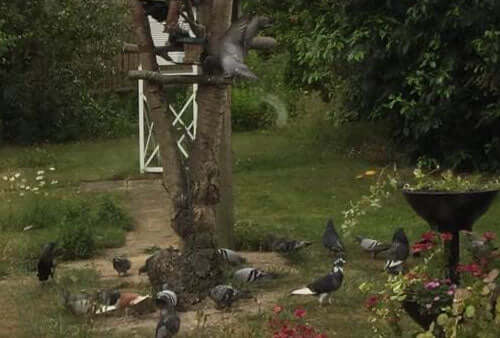
Move over because it is my turn now
Share
Activity at the bird table has continued apace during the last week and I’m now convinced that the feral pigeon numbers are bolstered by youngsters, as some of the ones I’m seeing seem to have different feather markings to the ‘regulars’.
You often think of pigeons just being grey and black with a bit of iridescence on the side of the neck, but that is certainly not the case. My picture this time shows some of the pigeons around the bird table and feeders but also is there to show the jackdaws which I’ll come to in a moment.

As you can see the pigeons seem to come in all varieties of colour and I seem to be getting an increasing number with white feathers to a lesser or greater degree. There is one predominately white pigeon that I’ve mentioned before, who just has a few splodges of black and there have been two others in the past week or so, one as far as I could tell was completely white and I don’t think it was a dove and another which was white apart from some patches of grey on its head. There are a number with white tail feathers or white underbellies or white wings so they’re obviously all mixing up together. There are also several coming in varying degrees of brown colouration.
The welcome rain in Kent of recent days has certainly provided more pickings for the starlings who as I write, are pecking away furiously at the lawn and using the feral pigeons for the safety in numbers routine. The starlings are also known for their squabbling at the feeders pushing one another out of the way because the other bird needs to move over as it’s my turn now! One way to clear the garden of birds is either if they see seagulls flying over or the large crow, who has been coming rather less frequently in the last week. He or she usually only makes a very quick visit down on the ground and then flies away.
The jackdaws have definitely been bringing their youngsters to the feeders and I recognise them as they look very fluffy and also seem to make the most noise, especially when they think the other birds should move over because it’s their turn. Several of the bird species have noted the fact that if they sit underneath the feeders they are likely to have some food that has fallen to the ground. One young jackdaw was walking around looking up in the air and you can imagine was saying, ‘Something will be falling here soon’. Several birds have also noticed that some of the suet will fall onto the old tree trunk where I hang my feeders and so they can climb up and pick something from there too.
The blue tits seem to have at least two youngsters, as they sometimes come to the bird table feeders for suet or peanuts and I have seen a couple of young robins as well. I imagine there is more food available in the countryside now as the blackbird family is making less frequent trips into the garden, although they are seen later in the day. A male blackbird was hopping about on the lawn at 9:45 pm just the other evening when it was still reasonably light.

The sparrows and some other smaller birds are enjoying the fact that there are some bugs and insects to pick up in the flower beds and as I planted out my geraniums this week, they have a bit of cover in one of the flower beds rather than it just being empty. I also have regular visits from up to four wood pigeons who often spend quite a bit of the day sitting on the top of the fence or the neighbour’s roof, just mulling over things and then come to the seed feeder either first thing in the morning or during the evening. There haven’t been any other exotic visitors that I’ve noticed recently but I’m always keeping my eye out for the return of the woodpecker, the jays and other more unusual sightings.
Written by Margaret Emerson
